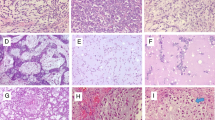Abstract
Purpose
Chondrosarcoma is a malignant bone tumor with poor prognosis. Surgical treatment is the first choice for chondrosarcomas. Chondrosarcoma is not sensitive to chemotherapy and radiotherapy. Identification of biological markers is important for the early diagnosis and targeted treatment of chondrosarcoma. This study investigated the protein expression and clinicopathological significance of ROR2 and FRAT1 in 59 chondrosarcomas and 33 osteochondromas.
Methods
ROR2 and FRAT1 protein expression in tissues was measured by immunohistochemistry.
Results
The percentage of positive ROR2 and FRAT1 expression was significantly higher in patients with chondrosarcoma than in patients with osteochondroma (P < 0.01). The percentage of positive ROR2 and FRAT1 expression was significantly lower in patients with histological grade I, AJCC stage I/II stage, Enneking stage I, non-metastatic and invasive chondrosarcoma than patients with histological grade III, AJCC stage III/IV, Enneking stage II + III, metastatic and invasive chondrosarcoma (P < 0.05 or P < 0.01). ROR2 expression was positively correlated with FRAT1 expression in chondrosarcoma. Kaplan–Meier survival analysis demonstrated that histological grade, AJCC stage, Enneking stage, metastasis, invasion, and ROR2 and FRAT1 expression significantly correlated with a short mean survival time of patients with chondrosarcoma (P < 0.05 or P < 0.01). Cox multivariate analysis showed that positive ROR2 and FRAT1 expression was an independent prognostic factor that negatively correlated with postoperative survival and positively correlated with mortality.
Conclusion
Positive ROR2 and FRAT1 expression is associated with the progression and poor prognosis of chondrosarcoma.



Similar content being viewed by others
References
Pritchard DJ, Lunke RJ, Taylor WF, Dahlin DC, Medley BE. Chondrosarcoma: a clinicopathologic and statistical analysis. Cancer. 1980;45:149–57.
Sekharappa V, Amritanand R, Krishnan V, David KS. Symptomatic solitary osteochondroma of the subaxial cervical spine in a 52-year-old patient. Asian Spine J. 2014;8:84–8.
Kim MJ, Cho KJ, Ayala AG, Ro JY. Chondrosarcoma: with updates on molecular genetics. Sarcoma. 2011;2011:405437.
Ford CE, Qian Ma SS, Quadir A, Ward RL. The dual role of the novel Wnt receptor tyrosine kinase, ROR2, in human carcinogenesis. Int J Cancer. 2013;133:779–87.
Niehrs C. The complex world of WNT receptor signaling. Nat Rev Mol Cell Biol. 2012;13:767–79.
Ren D, Minami Y, Nishita M. Critical role of Wnt5a-Ror2 signaling in motility and invasiveness of carcinoma cells following snail-mediated epithelial-mesenchymal transition. Genes Cells. 2011;16:304–15.
Saitoh T, Mine T, Katoh M. Molecular cloning and expression of proto-oncogene FRAT1 in human cancer. Int J Oncol. 2002;20:785–9.
van Amerongen R, Nawijn MC, Lambooij JP, Proost N, Jonkers J, Berns A. Frat oncoproteins act at the crossroad of canonical and noncanonical Wnt-signaling pathways. Oncogene. 2010;29:93–104.
Heymann D, Rédini F. Targeted therapies for bone sarcomas. Bonekey Rep. 2013;2:378.
O’Connell MP, Fiori JL, Xu M, Carter AD, Frank BP, Camilli TC, et al. The orphan tyrosine kinase receptor, ROR2, mediates Wnt5A signaling in metastatic melanoma. Oncogene. 2010;29:34–44.
Wright TM, Brannon AR, Gordan JD, Mikels AJ, Mitchell C, Chen S, et al. Ror2, a developmentally regulated kinase, promotes tumor growth potential in renal cell carcinoma. Oncogene. 2009;28:2513–23.
Katoh Y, Katoh M. Comparative integromics on FAT1, FAT2, FAT3 and FAT4. Int J Mol Med. 2006;18:523–8.
Edris B, Espinosa I, Mühlenberg T, Mikels A, Lee CH, Steigen SE, et al. ROR2 is a novel prognostic biomarker and a potential therapeutic target in leiomyosarcoma and gastrointestinal stromal tumour. J Pathol. 2012;227:223–33.
Lu BJ, Wang YQ, Wei XJ, Rong LQ, Wei D, Yan CM, et al. Expression of WNT-5a and ROR2 correlates with disease severity in osteosarcoma. Mol Med Rep. 2012;5:1033–6.
Morioka K, Tanikawa C, Ochi K, Daigo Y, Katagiri T, Kawano H, et al. Orphan receptor tyrosine kinase ROR2 as a potential therapeutic target for osteosarcoma. Cancer Sci. 2009;100:1227–33.
Lara E, Calvanese V, Huidobro C, Fernández AF, Moncada-Pazos A, Obaya AJ, et al. Epigenetic repression of ROR2 has a Wnt-mediated, pro-tumourigenic role in colon cancer. Mol Cancer. 2010;9:170.
Geng M, Cao YC, Chen YJ, Jiang H, Bi LQ, Liu XH. Loss of Wnt5a and Ror2 protein in hepatocellular carcinoma associated with poor prognosis. World J Gastroenterol. 2012;18:1328–38.
Daneshmanesh AH, Porwit A, Hojjat-Farsangi M, Jeddi-Tehrani M, Tamm KP, Grandér D, et al. Orphan receptor tyrosine kinases ROR1 and ROR2 in hematological malignancies. Leuk Lymphoma. 2013;54:843–50.
Endo M, Doi R, Nishita M, Minami Y. Ror family receptor tyrosine kinases regulate the maintenance of neural progenitor cells in the developing neocortex. Cell Sci. 2012;125:2017–29.
Al-Shawi R, Ashton SV, Underwood C, Simons JP. Expression of the Ror1 and Ror2 receptor tyrosine kinase genes during mouse development. Dev Genes Evol. 2001;211:161–71.
Saitoh T, Katoh M. FRAT1 and FRAT2, clustered in human chromosome 10q24.1 region, are up-regulated in gastric cancer. Int J Oncol. 2001;19:311–5.
van Amerongen R, Nawijn M, Franca-Koh J, Zevenhoven J, van der Gulden H, Jonkers J, et al. Frat is dispensable for canonical Wnt signaling in mammals. Genes Dev. 2005;19:425–30.
Wang Y, Liu S, Zhu H, Zhang W, Zhang G, Zhou X, et al. FRAT1 overexpression leads to aberrant activation of beta-catenin/TCF pathway in esophageal squamous cell carcinoma. Int J Cancer. 2008;123:561–8.
Zhang Y, Han Y, Zheng R, Yu JH, Miao Y, Wang L, et al. Expression of Frat1 correlates with expression of β-catenin and is associated with a poor clinical outcome in human SCC and AC. Tumour Biol. 2012;33:1437–44.
Wang Y, Hewitt SM, Liu S, Zhou X, Zhu H, Zhou C, et al. Tissue microarray analysis of human FRAT1 expression and its correlation with the subcellular localisation of beta-catenin in ovarian tumours. Br J Cancer. 2006;94:686–91.
Guo G, Mao X, Wang P, Liu B, Zhang X, Jiang X, et al. The expression profile of FRAT1 in human gliomas. Brain Res. 2010;1320:152–8.
Acknowledgments
This study was supported by the Central South University’s fund for independent exploration and innovation of Graduate (No.: 2013zzts336).
Conflict of interest
All authors declared no any conflict of interest.
Author information
Authors and Affiliations
Corresponding author
Rights and permissions
About this article
Cite this article
He, L., Yang, Z., Zhou, J. et al. The clinical pathological significance of FRAT1 and ROR2 expression in cartilage tumors. Clin Transl Oncol 17, 438–445 (2015). https://doi.org/10.1007/s12094-014-1254-y
Received:
Accepted:
Published:
Issue Date:
DOI: https://doi.org/10.1007/s12094-014-1254-y




